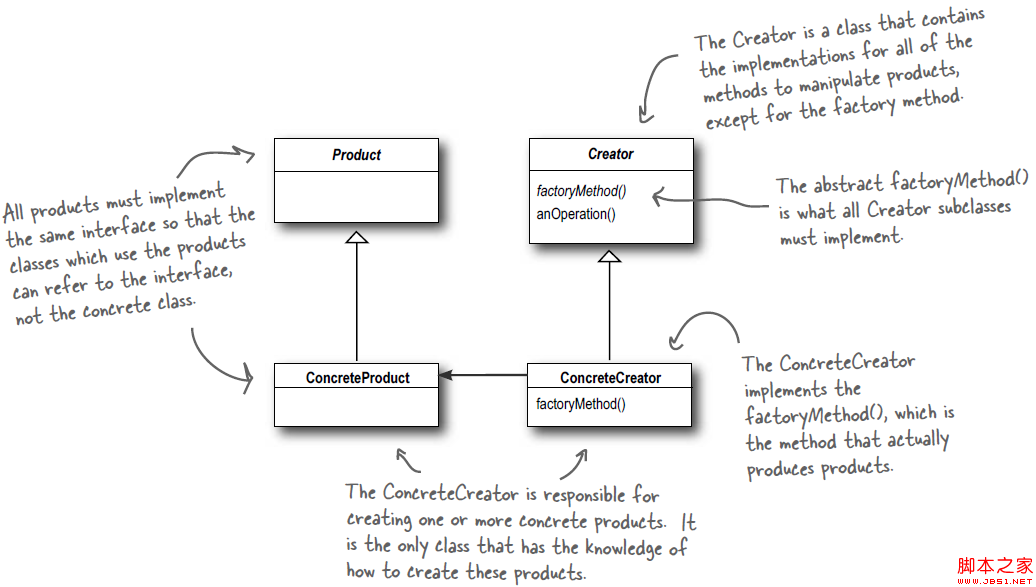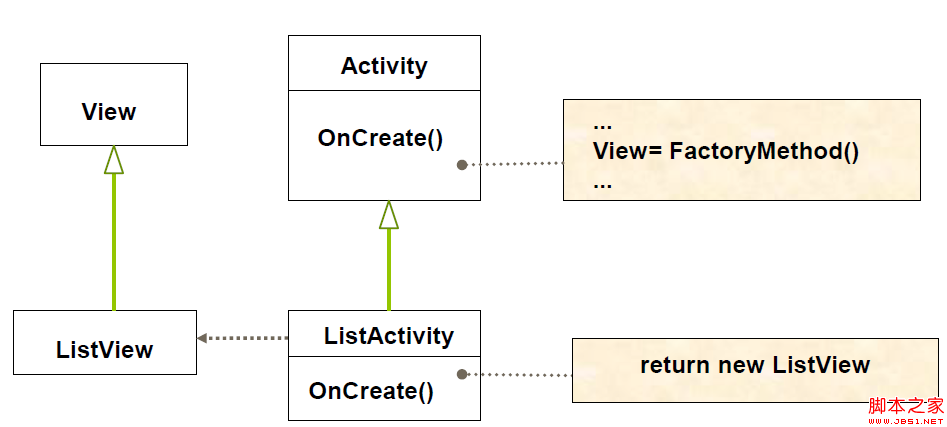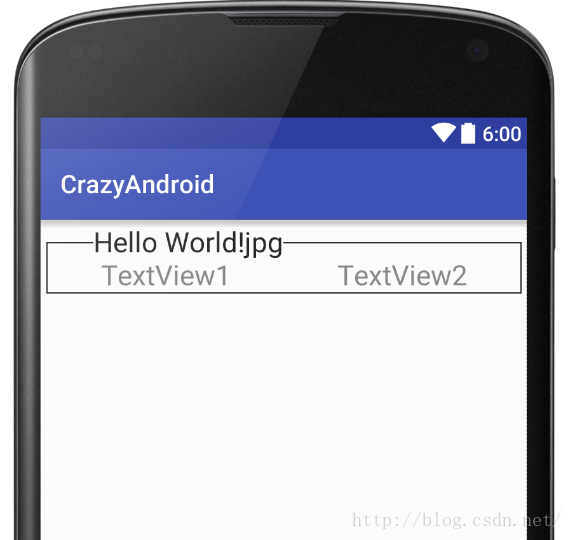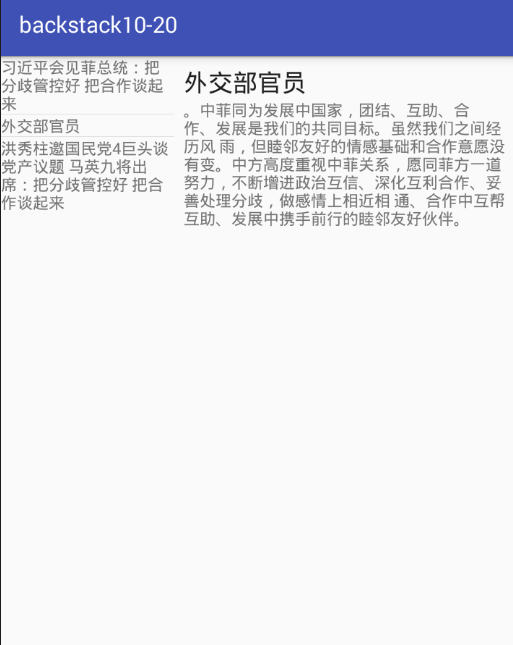工廠方法模式定義:
Define an interface for creating an object, but let subclasses decide which class to instantiate. Factory Method lets a class defer instantiation to subclasses.
定義一個用於創建對象的接口,讓子類決定實例化哪一個類。工廠方法使一個類的實例化延遲到其子類。
常用的工廠方法模式結構:

如上圖所示(截取自《Head First Design Patterns》一書),主要包括四個部分:
抽象產品類Product負責定義產品的共性,實現對事物抽象的定義;Creator是抽象創建類,也就是抽象工廠,具體如何創建產品類是由具體的實現工廠ConcreteCreator完成的。其中在《Head First Design Patterns》對工廠方法模式做了細節的說明,原文如下:
As in the official definition, you'll often hear developers say that the Factory Method lets subclasses decide which class to instantiate. They say “decides” not because the pattern allows subclasses themselves to decide at runtime, but because the creator class is written without knowledge of the actual products that will be created, which is decided purely by the choice of the subclass that is used.
工廠方法模式有什麼優勢呢:
良好的封裝性,代碼結構清楚。一個對象創建具有條件約束的,如果一個調用者需要一個具體的產品對象,只要知道這個產品的類名就可以了,不用知道創建對象的過程,降低模塊間的耦合。
可擴展性好。在增加產品類的情況下,只要適當的修改具體的工廠類或擴展一個工廠類,就可以完成。
屏蔽產品類。產品類的實現如何變化,調用者都不需要關心,它只需要關心產品的接口,只要接口保持不變,系統中的上層模塊就不用改變。因為產品類的實例化工作是由工廠類負責的,一個產品對象具體由哪一個產品生成是由工廠類決定的。此外工廠方法模式是典型的松耦合結構。高層模塊只需要知道產品的抽象類,其他的實現類都不用關系,符合迪米特法則、依賴倒置原則、裡氏替換原則等。
在Android源碼中,ListActivity繼承自Activity,將Activity作為工廠方法,生成具有ListView特點的Activity,對ListActivity的說明如下:
An activity that displays a list of items by binding to a data source such as an array or Cursor, and exposes event handlers when the user selects an item.
ListActivity hosts a ListView object that can be bound to different data sources, typically either an array or a Cursor holding query results. Binding, screen layout, and row layout are discussed in the following sections.
Screen Layout ListActivity has a default layout that consists of a single, full-screen list in the center of the screen. However, if you desire, you can customize the screen layout by setting your own view layout with setContentView() in onCreate(). To do this, your own view MUST contain a ListView object with the id "@android:id/list" (or listif it's in code)
在Activity類中有這麼一個函數:
復制代碼 代碼如下:
/**
* This method is called after {@link #onStart} when the activity is
* being re-initialized from a previously saved state, given here in
* <var>savedInstanceState</var>. Most implementations will simply use {@link #onCreate}
* to restore their state, but it is sometimes convenient to do it here
* after all of the initialization has been done or to allow subclasses to
* decide whether to use your default implementation. The default
* implementation of this method performs a restore of any view state that
* had previously been frozen by {@link #onSaveInstanceState}.
*
* <p>This method is called between {@link #onStart} and
* {@link #onPostCreate}.
*
* @param savedInstanceState the data most recently supplied in {@link #onSaveInstanceState}.
*
* @see #onCreate
* @see #onPostCreate
* @see #onResume
* @see #onSaveInstanceState
*/
protected void onRestoreInstanceState(Bundle savedInstanceState) {
if (mWindow != null) {
Bundle windowState = savedInstanceState.getBundle(WINDOW_HIERARCHY_TAG);
if (windowState != null) {
mWindow.restoreHierarchyState(windowState);
}
}
}
在注釋中“but it is sometimes convenient to do it here after all of the initialization has been done or to allow subclasses to decide whether to use your default implementation.”,英語不太好,但大致的意思是Activity子類可以重載這個函數來決定是否使用默認的實現。
在看子類ListActivity:
復制代碼 代碼如下:
public class ListActivity extends Activity {
/**
* This field should be made private, so it is hidden from the SDK.
* {@hide}
*/
protected ListAdapter mAdapter;
/**
* This field should be made private, so it is hidden from the SDK.
* {@hide}
*/
protected ListView mList;
private Handler mHandler = new Handler();
private boolean mFinishedStart = false;
private Runnable mRequestFocus = new Runnable() {
public void run() {
mList.focusableViewAvailable(mList);
}
};
/**
* This method will be called when an item in the list is selected.
* Subclasses should override. Subclasses can call
* getListView().getItemAtPosition(position) if they need to access the
* data associated with the selected item.
*
* @param l The ListView where the click happened
* @param v The view that was clicked within the ListView
* @param position The position of the view in the list
* @param id The row id of the item that was clicked
*/
protected void onListItemClick(ListView l, View v, int position, long id) {
}
/**
* Ensures the list view has been created before Activity restores all
* of the view states.
*
*@see Activity#onRestoreInstanceState(Bundle)
*/
@Override
protected void onRestoreInstanceState(Bundle state) {
ensureList();
super.onRestoreInstanceState(state);
}
/**
* @see Activity#onDestroy()
*/
@Override
protected void onDestroy() {
mHandler.removeCallbacks(mRequestFocus);
super.onDestroy();
}
/**
* Updates the screen state (current list and other views) when the
* content changes.
*
* @see Activity#onContentChanged()
*/
@Override
public void onContentChanged() {
super.onContentChanged();
View emptyView = findViewById(com.android.internal.R.id.empty);
mList = (ListView)findViewById(com.android.internal.R.id.list);
if (mList == null) {
throw new RuntimeException(
"Your content must have a ListView whose id attribute is " +
"'android.R.id.list'");
}
if (emptyView != null) {
mList.setEmptyView(emptyView);
}
mList.setOnItemClickListener(mOnClickListener);
if (mFinishedStart) {
setListAdapter(mAdapter);
}
mHandler.post(mRequestFocus);
mFinishedStart = true;
}
/**
* Provide the cursor for the list view.
*/
public void setListAdapter(ListAdapter adapter) {
synchronized (this) {
ensureList();
mAdapter = adapter;
mList.setAdapter(adapter);
}
}
/**
* Set the currently selected list item to the specified
* position with the adapter's data
*
* @param position
*/
public void setSelection(int position) {
mList.setSelection(position);
}
/**
* Get the position of the currently selected list item.
*/
public int getSelectedItemPosition() {
return mList.getSelectedItemPosition();
}
/**
* Get the cursor row ID of the currently selected list item.
*/
public long getSelectedItemId() {
return mList.getSelectedItemId();
}
/**
* Get the activity's list view widget.
*/
public ListView getListView() {
ensureList();
return mList;
}
/**
* Get the ListAdapter associated with this activity's ListView.
*/
public ListAdapter getListAdapter() {
return mAdapter;
}
private void ensureList() {
if (mList != null) {
return;
}
setContentView(com.android.internal.R.layout.list_content_simple);
}
private AdapterView.OnItemClickListener mOnClickListener = new AdapterView.OnItemClickListener() {
public void onItemClick(AdapterView<?> parent, View v, int position, long id)
{
onListItemClick((ListView)parent, v, position, id);
}
};
}
其中復寫了函數onRestoreInstanceState(Bundle state),並在View中設置了默認的setContentView(com.android.internal.R.layout.list_content_simple);
復制代碼 代碼如下:
/**
* Ensures the list view has been created before Activity restores all
* of the view states.
*
*@see Activity#onRestoreInstanceState(Bundle)
*/
@Override
protected void onRestoreInstanceState(Bundle state) {
ensureList();
super.onRestoreInstanceState(state);
}
。。。
private void ensureList() {
if (mList != null) {
return;
}
setContentView(com.android.internal.R.layout.list_content_simple);
}
Activity中的setContentView()函數:
復制代碼 代碼如下:
/**
* Set the activity content from a layout resource. The resource will be
* inflated, adding all top-level views to the activity.
*
* @param layoutResID Resource ID to be inflated.
*
* @see #setContentView(android.view.View)
* @see #setContentView(android.view.View, android.view.ViewGroup.LayoutParams)
*/
public void setContentView(int layoutResID) {
getWindow().setContentView(layoutResID);
initActionBar();
}
/**
* Set the activity content to an explicit view. This view is placed
* directly into the activity's view hierarchy. It can itself be a complex
* view hierarchy. When calling this method, the layout parameters of the
* specified view are ignored. Both the width and the height of the view are
* set by default to {@link ViewGroup.LayoutParams#MATCH_PARENT}. To use
* your own layout parameters, invoke
* {@link #setContentView(android.view.View, android.view.ViewGroup.LayoutParams)}
* instead.
*
* @param view The desired content to display.
*
* @see #setContentView(int)
* @see #setContentView(android.view.View, android.view.ViewGroup.LayoutParams)
*/
public void setContentView(View view) {
getWindow().setContentView(view);
initActionBar();
}
/**
* Set the activity content to an explicit view. This view is placed
* directly into the activity's view hierarchy. It can itself be a complex
* view hierarchy.
*
* @param view The desired content to display.
* @param params Layout parameters for the view.
*
* @see #setContentView(android.view.View)
* @see #setContentView(int)
*/
public void setContentView(View view, ViewGroup.LayoutParams params) {
getWindow().setContentView(view, params);
initActionBar();
}

總結:Activity作為“工廠方法”,具體View中顯示什麼由默認設置或者由子類來實現;ListActivity作為具體實現,它決定在View中顯示的是ListView;這裡的View是Activity中的默認顯示,即為“Product”,而ListView是“ConcreteProduct”,由ListActivity來決定顯示。
除了ListActivity以外,還有ExpandableListActivity也是以Activity為工廠類,創建自己的顯示效果。
本人能力和時間有限(缺少“模式使用”內容,以後會添加),寫的很粗糙,恭候大家的批評指正,謝謝~~~


 Android自定義帶標題邊框的Layout
Android自定義帶標題邊框的Layout
 Android--百度地圖開發(二)
Android--百度地圖開發(二)
 下載、編譯、運行android 7.1系統詳解(ubuntu 16.0.4)
下載、編譯、運行android 7.1系統詳解(ubuntu 16.0.4)
 Android Fragment的回退棧示例詳細介紹
Android Fragment的回退棧示例詳細介紹